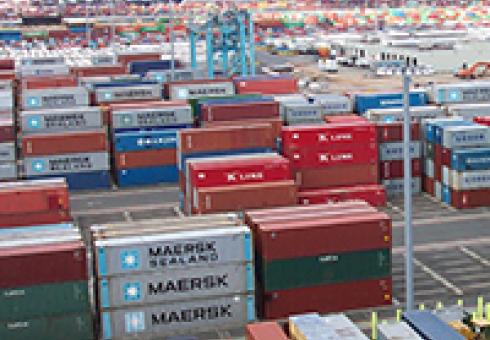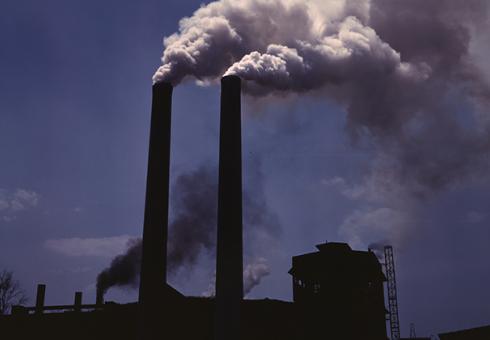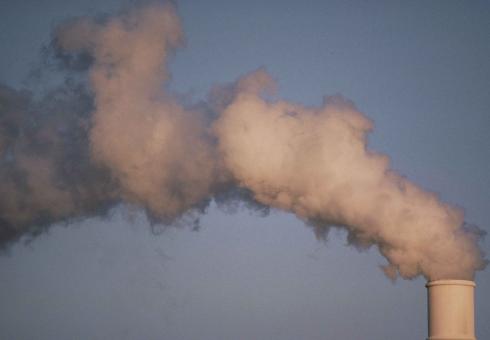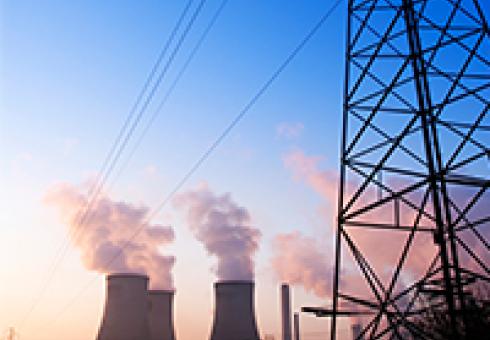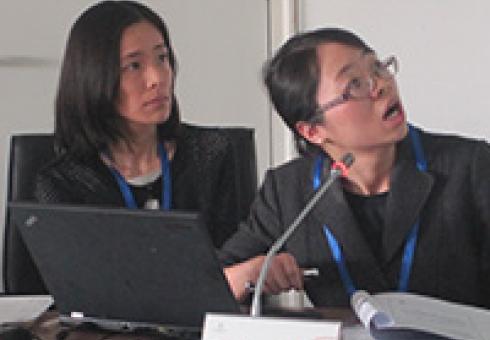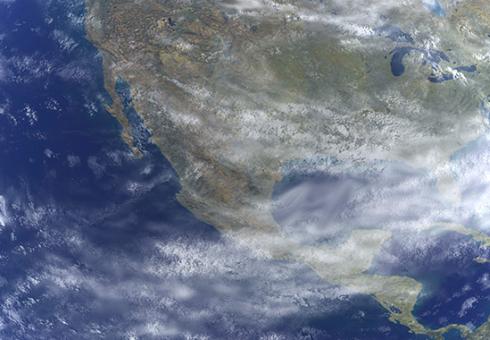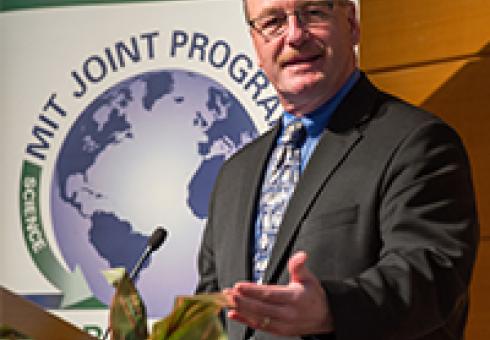News Releases
Alli Gold Roberts
MIT Joint Program on the Science and Policy of Global Change
China is the world’s second largest national economy and its largest exporter. This growth has come at a cost, with energy demands and associated environmental damages on the rise. China is now the world leader in consumer energy use and CO2 emissions. As countries around the globe work to reduce carbon emissions, policymakers are interested in measuring and ultimately reducing emissions associated with the relocation of industry and manufacturing overseas.
In a study released in the March issue of Energy Economics, researchers at Tsinghua University and MIT developed a new model to determine if policy proposals could help reduce carbon emissions associated with goods exported from China. They found that taxes on energy-intensive exports and policies encouraging the Chinese economy to shift from industry to services are ineffective in significantly reducing total CO2 emissions, because the same goods would still be produced elsewhere.
“Developed countries are discussing the possibility of imposing a trade tariff on emissions embodied in imported goods in an effort to prevent the relocation of high-emitting industries overseas and to shore up domestic competitiveness,” says Tianyu Qi, a PhD student at Tsinghua University and the lead author of the study. “It is important to understand how vulnerable the Chinese economy is to such a policy.”
Approximately 22 percent of China’s CO2 emissions are the result of net exports. These emissions are categorized as “trade-embodied” emissions because they are produced as a result of goods and services that are exported.
In their analysis, the researchers considered the impacts of two policies that are similar to measures included in China’s Twelfth Five-Year Plan. The first policy is a tax on energy-intensive exports and the second policy involves incentivizing a shift in China’s economy away from industry and towards services.
“In exploring these policies—both of which are advertised as carbon-reducing strategies—we find that neither would have a significant impact on total global emissions because reduced production in China is partially offset by increased production elsewhere,” says Qi, also a researcher with the MIT-Tsinghua China Energy and Climate Project.
If policymakers want to simply reduce emissions associated with China’s trade, the researchers suggest policies that support economic structural changes.
“A policy that targets the expansion of domestic demand, along with a shift toward services, is more effective at reducing China’s export-embodied CO2 emissions,” says Valerie Karplus, co-author of the study and the director of the Tsinghua-MIT China Energy and Climate Project. “This will in turn reduce China’s exposure to potential tariffs on embodied carbon imposed overseas.”
Karplus explains that such a move is not a long-term solution to reducing CO2 emissions and would ultimately shift production of many industrial products to other nations—shifting emissions along with them.
The researchers also find that the EU, the U.S. and Japan are the largest net recipients of trade-embodied CO2 emissions. In addition, the researchers expected energy-intensive industries such as steel and aluminum production to be responsible for most of the CO2 emissions associated with China’s trade, but instead they found the production of machinery and equipment to be the main culprit.
“This because China exports large volumes of machinery and equipment products, such as refrigerators and televisions, even though commodities such as aluminum and steel are more CO2-intensive than these products,” explains Niven Winchester, an environmental economist in MIT’s Joint Program on the Science and Policy of Global Change and a co-author of the study.
To analyze the impact of policies on CO2 emissions, the MIT-Tsinghua China Energy and Climate Project developed a new model called the China-in-Global Energy Model, or C-GEM. C-GEM disaggregates China’s 30 provinces and details the entire energy system. The model also includes global trade data to measure the interactions between China and the global economy.
The Tsinghua-MIT China Energy and Climate Project is a collaborative effort between the MIT Joint Program on the Science and Policy of Global Change and the Institute for Energy, Environment and Economy at Tsinghua University in Beijing, China. This group is working to analyze the impact of existing and proposed energy and climate policies in China on technology, energy use, the environment and economic welfare.
Alli Gold Roberts
MIT Joint Program on the Science and Policy of Global Change
By the late 1990s, scientists had observed more than two decades of rapid global warming, and expected the warming trend to continue. Instead, despite continuing increases in greenhouse gas emissions, the Earth’s surface temperatures have remained nearly flat for the last 15 years. The International Panel on Climate Change verified this recent warming “hiatus” in its latest report.
Researchers around the globe have been working to understand this puzzle—looking at heat going into the oceans, changes in wind patterns, and other factors to explain why temperatures have stayed nearly stable, while greenhouse gas concentrations have continued to rise. In a study published today in Nature Geoscience, a team of scientists from MIT and elsewhere around the U.S. report that volcanic eruptions have contributed to this recent cooling, and that most climate models have not accurately accounted for the effects of volcanic activity.
“This is the most comprehensive observational evaluation of the role of volcanic activity on climate in the early part of the 21st century,” says co-author Susan Solomon, the Ellen Swallow Richards Professor of Atmospheric Chemistry and Climate Science at MIT. “We assess the contributions of volcanoes on temperatures in the troposphere—the lowest layer of the atmosphere—and find they’ve certainly played some role in keeping the Earth cooler.” 
There are many components of the Earth’s climate system that can increase or decrease the temperature of the globe. For example, while greenhouse gases cause warming, some types of small particles, known as aerosols, cause cooling. When volcanoes erupt explosively enough, they enhance these aerosols—a phenomenon referred to as “volcanic forcing.”
“The recent slowdown in observed surface and tropospheric warming is a fascinating detective story,” says Ben Santer, the lead author of the study and a climate scientist at Lawrence Livermore National Laboratory. “There is not a single culprit, as some scientists have claimed. Multiple factors are implicated. The real scientific challenge is to obtain hard quantitative estimates of the contributions of each of these factors to the so-called slowdown.”
The researchers verified the cooling phenomenon by performing two different statistical tests to determine whether recent volcanic eruptions have cooling effects that can be distinguished from the intrinsic variability of the climate. The team found evidence for significant correlations between volcanic aerosol observations and satellite-based estimates of both tropospheric temperature and sunlight reflected by the particles off the top of the atmosphere.
“What’s exciting in this work was that we could detect the influence of the volcanic aerosols in new ways. Using satellite observations confirmed the fact that the volcanic particles reflected a significant amount of the sun’s energy out to space, and of course losing energy means cooling—and the tropospheric temperatures show that too,” explains Solomon, who is also a researcher with MIT’s Joint Program on the Science and Policy of Global Change. “There are still uncertainties in exactly how big the effects are, so there is more work to do.”
Alan Robock, a professor of environmental sciences at Rutgers University and a leading expert on the impacts of volcanic eruptions on climate, says these findings are an important part of the larger climate picture. “This paper reminds us that there are multiple causes of climate change, both natural and anthropogenic, and that we need to consider all of them when interpreting past climate and predicting future climate.”
“Since none of the standard scenarios for evaluating future global warming include volcanic eruptions,” Robock adds, “this paper will help us quantify the impacts of future large and small eruptions when they happen, and thus better interpret the role of humans in causing climate change.”
This research was led by a team at Lawrence Livermore National Laboratory and builds upon work Solomon conducted in 2011, finding that aerosols in an upper layer of the atmosphere—the stratosphere—are persistently variable and must be included in climate models to accurately depict climate changes.
The research was supported by the U.S. Department of Energy.
Alli Gold Roberts
MIT Joint Program on the Science and Policy of Global Change
Black carbon is one of the most potent air pollutants that contributes to global climate change, and is produced by the incomplete combustion of fossil fuels and forest fires. While scientists have known about the role of black carbon for decades, there’s been limited research to calculate global emissions. Now, MIT and National University of Singapore (NUS) researchers have developed a new method to calculate global black carbon emissions.
In a study published in last week’s Journal of Geophysical Research, the researchers calculated the global total of black carbon emissions at 17 teragrams a year between 2000 and 2005. This result is significantly larger than the majority of global air pollution modeling studies, which employ a bottom-up approach. One such study found humans emitted only 7.5 teragrams of black carbon per year during the same five-year period—less than half the new estimate.
“Our results are the first to produce a global top-down estimation of the emissions of black carbon,” says Chien Wang, a senior research scientist with the Joint Program on the Science and Policy of Global Change and co-author of the study.
The top-down method used by Wang and his co-author Dr. Jason Cohen of NUS relies on gathering data from air measurement stations and satellites to sufficiently cover every region of the globe. In this study, data was collected from 238 different stations. They then compiled this data and used inverse modeling to determine the emissions from each of the major pollution regions.
“Current emissions inventories are mainly obtained by adding up estimates of emissions from ever sector of the economy and the environment to obtain a global estimate. This method creates uncertainty in the projections,” says Wang. “Our method eliminates some of these uncertainties by more accurately factoring in population and economic changes around the globe.”
The differences in the emissions estimates are most apparent in China and Southeast Asia. Wang predicts this is the result of the bottom-up method not capturing the rapid socioeconomic growth that has occurred in this region over the past 15 years.
Black carbon enters the atmosphere as small particles and warms the planet by absorbing heat and reducing the ability of the Earth to reflect light back out to space.
Because black carbon plays a key role in air pollution and global climate change, it is essential for policymakers to have an accurate picture of the severity of the problem.
“This top-down method isn’t perfect and still creates some unknowns in the estimates produced,” Wang says, but he suggests that combining both approaches would potentially improve estimates and further eliminate uncertainty. “We hope this work will open the door to further efforts to better quantify and reduce uncertainty in black carbon emissions estimates.”
More: Reprint 2014-1
Alli Gold Roberts
MIT Joint Program on the Science and Policy of Global Change
Population growth and increasing social pressures on global water resources have required communities around the globe to focus on the future of water availability. Global climate change is expected to further exacerbate the demands on water-stressed regions. In an effort to assess future water demands and the impacts of climate change, MIT researchers have used a new modeling tool to calculate the ability of global water resources to meet water needs through 2050.
The researchers expect 5 billion (52 percent) of the world’s projected 9.7 billion people to live in water-stressed areas by 2050. They also expect about 1 billion more people to be living in areas where water demand exceeds surface-water supply. A large portion of these regions already face water stress—most notably India, Northern Africa and the Middle East.
The study applies the MIT Integrated Global System Model Water Resource System (IGSM-WRS), a modeling tool with the ability to assess both changing climate and socioeconomics—allowing the researchers to isolate these two influencers. In studying the socioeconomic changes, they find population and economic growth are responsible for most of the increased water stress. Such changes will lead to an additional 1.8 billion people globally living in water-stressed regions.
“Our research highlights the substantial influence of socioeconomic growth on global water resources, potentially worsened by climate change,” says Adam Schlosser, the assistant director of science research at the Joint Program on Global Change and lead author of the study. “Developing nations are expected to face the brunt of these rising water demands, with 80 percent of this additional 1.8 billion living in developing countries.”
Looking at the influence of climate change alone, the researchers find a different result. Climate change will have a greater impact on water resources in developed countries. This is because, for instance, changes in precipitation patterns would limit water supplies needed for irrigation.
When researchers combine the climate and socioeconomic scenarios, a more complicated picture of future water resources emerges. For example, in India, researchers expect to see significant increases in precipitation, contributing to improved water supplies. However, India’s projected population growth and economic development will cause water demands to outstrip surface-water supply.
“There is a growing need for modeling and analysis like this, which takes a comprehensive approach by studying the influence of both climatic and socioeconomic changes and their effects on both supply and demand projections,” says Schlosser. “Our results underscore this need.”
The MIT team plans to continue this work by focusing on specific regions and conducting more detailed analysis of future climate changes and risks to water systems. They plan to refine and add to the model as they research other regions of the globe.
Alli Gold Roberts
MIT Joint Program on the Science and Policy of Global Change
Despite global treaties and national regulations limiting toxic chemicals known as persistent organic pollutants (POPs), many of these chemicals still remain in the environment for long periods of time and accumulate in our land, water and air. These chemicals reach remote regions of the globe, like the Arctic, through air currents and have dangerous effects on humans and animals. Warming of the atmosphere and changing patterns of wind and rain, due to climate change, can affect where and when these pollutants travel. However, the impact of climate on POPs—how these patterns will change, and in what direction—is not well known.
In a new study published in Environmental Science and Technology, MIT researchers assess the impacts of both climate change and future emissions on a group of POPs called polycyclic aromatic hydrocarbons (PAHs)—toxic byproducts of burning wood, coal and oil. They are the first to address the influence of climate change on the transport of PAHs.
They find that decreases in human emissions are expected to cause PAH concentrations to decline by up to 37 percent by 2050. But, climate change can either reduce or enhance that decline depending on the physical and chemical properties of different PAHs.
“We are interested in PAHs because they continue to be released into the atmosphere and their concentrations have been increasing in Arctic marine life, in contrast to most other POPs,” says Carey Friedman, a postdoctoral associate with the MIT Joint Program on the Science and Policy of Global Change and the lead author of the study. “We find that projected decreases in human emissions will have a stronger impact on atmospheric PAH levels in the future than changes in climate.”
However, the authors find that this statement has important caveats. As temperatures rise, due to climate change, more volatile PAHs that are currently deposited in soil and vegetation are expected be emitted—actually re-emitted—into the atmosphere.
“This represents a ‘climate penalty’ for atmospheric concentrations of more volatile PAHs, meaning that emissions reductions will not be as effective as they would have been if the climate wasn’t changing,” explains Noelle Selin, co-author of the study and an assistant professor of engineering systems and atmospheric chemistry.
In contrast, atmospheric levels of non-volatile PAHs are expected to decrease under 2050 climate conditions because their ability to be deposited into the soil and land will be enhanced.
“Our results suggest that ratios of the different types of PAHs (volatile to non-volatile) in the Arctic can be used to diagnose whether the atmosphere is experiencing greater influence from climate change or reductions in human emissions,” says Friedman.
This raises the possibility that such a technique could be used to measure the effectiveness of emissions reduction activities in the context of ongoing climate change.
The study is part a series of NSF-funded research tracking how chemicals travel to remote Arctic environments and how they can be better managed. Researchers have presented the results of these studies to help inform policymakers on the most effective methods of addressing POPs like PAHs, which are affecting humans and the environment.
Read about the team’s earlier research results: http://globalchange.mit.edu/research/publications/search
Alli Gold Roberts
MIT Joint Program on the Science and Policy of Global Change
Policies to curb greenhouse gas emissions will come at a cost to energy producers, industry and consumers. Policymakers around the globe are working to determine the most effective and cost efficient way to reduce these emissions—from renewable energy subsidies and fuel efficiency standards to carbon taxes and cap-and-trade policies.
To tackle this challenge, Sergey Paltsev from MIT and Pantelis Capros from the National Technical University of Athens have come together to assess which methods and metrics are best for calculating the cost of climate policies. In their study, published this week in Climate Change Economics, they find that there is no one ideal metric for climate mitigation policies, but measuring changes in consumer welfare is one of the most appropriate techniques.
“With many of these regulations, the total costs are often less visible to consumers because the true costs are not reflected in the price of energy, but distributed to other sectors of the economy,” says Paltsev, the assistant director for economic research at the MIT Joint Program on the Science and Policy of Global Change. “The true measure of the cost of a policy is reflected in the change in consumers’ behavior, something that economists call as ‘change in welfare,’ but it is hard to convey this measure to policy makers and general public.”
In the study, the researchers compare different concepts that are used to inform the public about the cost implications of climate change. They consider two major modeling types where costs are calculated, energy system models and macroeconomic models. Energy system models focus solely on the energy sector and treat the rest of the economy as a given. Macroeconomic models represent the energy system as part of the entire economy and provide more detailed information on the various sectors. Within these approaches there are a variety of metrics used to calculate the cost of a climate mitigation policy.
After studying the cost metrics associated with each modeling approach, the researchers compared the metrics used by a team of international researchers to better understand the impacts of the current EU emissions targets (the EU Energy Modeling Forum 28 study). They find that there are large variations in cost estimates and most metrics are not directly comparable, which makes it difficult for policymakers to interpret the results of these studies.
Paltsev says there is no ideal metric for costs, but it’s clear that some approaches are more effective than others. For example, carbon prices and marginal abatement cost curves are unable to reflect the full impact of the policy on the economy. In addition, energy system models do not always take into account the full cost of a climate policy—particularly the economic impacts of policies interacting with one another. The authors recognize that depending on the objectives, other metrics and modeling techniques may be appropriate. They conclude that measuring changes in consumer welfare or consumption is an effective approach that should be used by policymakers to evaluate climate policies.
Vicki Ekstrom
MIT Joint Program on the Science and Policy of Global Change As countries try to protect their domestic air carriers from a European Union proposal that would put a price on the emissions they release over European airspace, the global aviation industry is working to curb those emissions. Industry-wide, air carriers set a goal to be carbon neutral by 2020 and cut their emissions in half by 2050. One way they’ll meet this goal is through the use of biofuels.
As countries try to protect their domestic air carriers from a European Union proposal that would put a price on the emissions they release over European airspace, the global aviation industry is working to curb those emissions. Industry-wide, air carriers set a goal to be carbon neutral by 2020 and cut their emissions in half by 2050. One way they’ll meet this goal is through the use of biofuels.
“Biofuels release significantly fewer emissions than conventional fuel, and could reduce fuel price volatility for airlines,” says Niven Winchester, an economist at the Joint Program on the Science and Policy of Global Change and the lead author of a study looking at the costs and efficiency of making the switch.
To meet the global targets, the U.S. Federal Aviation Administration has set its own goal to use one billion gallons of renewable biofuels each year starting in 2018. Because the goal includes U.S. Air Force and Navy carriers, which consume the vast majority of fuel, commercial airlines are responsible for just 35 percent of the target (350 million gallons). In studying this target, Winchester and his co-authors find that while a carbon tax or cap-and-trade system – as the Europeans have employed – would be the most efficient way to reduce emissions, there are ways to cut the costs of using biofuels. The study was published in the December issue of Transportation Research.
“The cost of abating emissions in the aviation sector is higher than in other sectors, so a broad cap-and-trade or carbon price policy that covers a variety of sectors would spread out those costs and allow for improvements in technology and infrastructure,” Winchester says. “But because employing a carbon tax or cap-and-trade appears to be politically infeasible at this time in the U.S., we looked for other ways to reduce emissions.”
The researchers find that growing biofuel crops in rotation with food crops, as research from the U.S. Department of Agriculture suggests, can reduce the cost of biofuels. Pennycress, for example, is a winter annual crop that could potentially be grown in the Midwest in rotation with summer corn and spring soybean crops.
The researchers found that without any policy to constrain emissions, airlines will spend $3.41 per gallon of fuel in 2020, or about $71 billion for the year. Using biofuels that are not grown in rotation with food crops would cost $6.08 per gallon – almost double the cost of conventional fuel. But because the biofuel target for commercial aviation represents only 1.7 percent of total fuel purchased by the industry, the average fuel costs for commercial carriers would increase by only $0.04 per gallon. While a seemingly small change, airlines would spend $830 million more per year on fuel. That price tag becomes significantly smaller when biofuels are grown as rotation crops. In this scenario, the average fuel costs could increase by as little as less than one cent per gallon – raising total annual fuel costs by about $125 million.
Using rotation crops is not only a cheaper way of reaching the renewable target, it also delivers greater bang for the buck in terms of reducing emissions – costing just $50 per ton of COâ‚‚ abated versus $400 per ton without their use. But again, it’s far from the most efficient option: a broad carbon tax or cap-and-trade system. Under the European Union’s Emissions Trading System, COâ‚‚ cost $5 per ton in mid-2013, and is predicted to cost $7 per ton in 2018.
“Because biofuels would account for such a small portion of the total fuel used by commercial aviation, meeting the goal would have only a minor impact on the price of jet fuel. But it would also have a minor impact on emissions,” Winchester says. “A broad cap-and-trade policy or a carbon offsetting scheme, as is currently being promoted by the International Air Transport Association, would reduce emissions at a lower cost by allowing aviation to tap into low-cost abatement options in other industries.”
The study was funded by the U.S. Federal Aviation Administration.
By Alli Gold Roberts
MIT Joint Program on the Science and Policy of Global Change
The MIT-Tsinghua China Energy and Climate Project and Emory University held a workshop on Thursday November 21st with researchers and government officials to discuss new research analyzing the impacts of China’s vehicle emissions policies. Researchers worked with policymakers to develop policy scenarios for a new integrated model that will analyze the emissions, air quality, economic, and public health impacts of policy proposals.
A joint team of researchers from Emory University, MIT, and Tsinghua University is carrying out the study. The project is supported by a grant from the Energy Foundation, which provides resources to institutions that most effectively leverage change in transitioning to a sustainable energy future. The Institute for Energy, Environment, and Economy at Tsinghua University hosted the workshop on their Tsinghua campus. At the meeting, policymakers, researchers, and other stakeholders engaged in a detailed, candid discussion of policy developments and scenario designs. The first meeting to launch this effort was held in March of 2013.
“This study will help policymakers understand the implications of taking more aggressive steps to control transportation emissions, particularly emissions from road vehicles, which have been outlined in the country’s new air pollution action plan,” says Dr. Valerie Karplus, who leads the MIT-Tsinghua China Energy and Climate Project. “Our framework allows us to quantify the costs and benefits of these measures within a single integrated framework.”
The meeting included representatives from the Chinese Ministry of Finance, Integrated Energy and Climate Policy Bureaus of the National Development and Reform Commission, Ministry of Industry and Information Technology, National Vehicle Emissions Control Center of the Ministry of Environment, and the Beijing Environmental Protection Bureau. The MIT, Tsinghua and Emory researchers used this workshop to communicate their results to policymakers and receive their input in designing policy scenarios for their model.
Using the China Regional Energy Model (C-REM), the group will model the impacts of China’s current and future transportation policies on the national economy and in the individual 30 provinces. The C-REM model was developed as part of the MIT-Tsinghua China Energy and Climate Project over the past two years. Recent modeling efforts include adding detail on the transportation sector and connecting the energy and economic data with a comprehensive inventory of China’s provincial emissions. The team used an atmospheric chemistry model to simulate air quality, including concentrations of ozone and particulate matter. Population-weighted concentrations are then used to simulate impacts on human health and economic activity.
The group plans to test three policy scenarios that will meet the needs of decision makers working on transport policy in China. They currently plan to test a no policy “business as usual” case for comparison, a current policies scenario, and an accelerated scenario that implements a more aggressive transport-focused pollution policy. The aggressive policy scenario focuses mainly on the role of tighter standards for fuel quality and vehicle tailpipe emissions.
“China’s leaders are placing ever greater emphasis on improving air quality and the environment,” says Eri Saikawa, assistant professor at Emory University and principal investigator on the project. “Policymakers are eager to identify specific measures that will help to achieve these goals.”
While building the transportation section of the model, researchers found that freight transport dominates energy use and emissions in most provinces, except the more urbanized regions. In addition, private vehicle ownership is rising rapidly and will have major implications for future emissions.
“China’s leaders have an opportunity to manage this growth by accelerating the adoption of low emissions vehicles nationwide,” says Karplus.
Over the coming months, the group will continue to improve the modeling framework and simulate the three policy scenarios. The final results will be shared with policymakers by the end of 2014.
The next meeting is planned for March of 2014.
By Vicki Ekstrom
Read the 2013 Energy and Climate Outlook
As international negotiators discuss global efforts to confront climate change at the 19th United Nation’s Conference of Parties (COP19), a group of MIT researchers suggest that the current regional efforts may not be enough to avoid the dangerous consequences of rising emissions.

“As our global population swells to more than 10 billion by the end of this century, climate change is one of the forces of global change that will shape how the world feeds, shelters, transports, and otherwise attends to this growing mass of people,” says John Reilly, co-director of the Joint Program on the Science and Policy of Global Change and an author of the 2013 Energy and Climate Outlook. “Our latest Outlook is a window into the future as we view it in 2013, but it is still in our power to change what we see by taking action.”
While much of the Outlook’s projections remain the same as in their 2012 Outlook – highlighting that large or developing countries will play a greater role in shaping our global challenges over time – shifting trends and new and updated data have led to subtle changes. One such trend is the growing use of natural gas and, to a lesser extent, renewable energy. Policies such as the European Union’s Emissions Trading System (and assuming Europe continues on its announced post 2020 policies)helped bring about some of these changes; cutting Europe’s coal generation in 2050 by almost half compared to the last Outlook. The U.S. is also expected to generate 35 percent more renewable energy and 15 percent more natural gas by 2050 compared to the 2012 Outlook.
Taking into account these resource and policy changes, the researchers project global natural gas consumption by 2050 to be 8 percent higher than their 2012 estimates, with China’s consumption alone more than tripling. They also project global consumption of renewable sources by 2050 to be 13 percent higher, while coal and oil usage will sink slightly (3 percent).
Changes in the global energy mix are partly responsible for a 12 percent dip in the projected CO2 emissions by the end of the century. Yet, these emissions are still projected to be 95 percent higher than in 2010. Even with cumulative emissions sinking slightly, the Outlook projects the world will warm by 3 to 6°C by 2100 compared to 2000, with the median forecast at 3.8°C.
“With natural gas becoming more and more important to the global energy mix each year, and recent policy efforts spurring an increased use of renewables, we do believe there will be slightly fewer emissions than we originally forecasted,” says Sergey Paltsev, an author of the study and the assistant director for economic research at the Joint Program on Global Change. “But, while growing at a slightly lesser rate, emissions are still increasing, and if they continue to grow we might experience very harmful consequences.”
Building on the models used for their 2012 Outlook, the researchers identify the hottest and coldest regions and the range of uncertainty. They find that generally the polar areas display the most warming, with Northern Canada and Siberia warming between 6 and 12°C by 2100. Meanwhile, North America, Europe and Asia can expect temperatures to warm by as much as 4 to 8°C, and Africa, Australia and South America can expect temperature increases between 3 and 7°C. The researchers also warn there could be very damaging consequences from an increase in extreme precipitation events, such as floods. Their analysis shows most land areas will become wetter, while over the ocean and Tropics a few regions could become drier.
“Taking into account the vast uncertainty in climate projections, even in our most optimistic scenario we see that these changes will surely impact food and water resources, among other changes,” says Erwan Monier, an author of the study and a scientist at the Joint Program on Global Change.
As in the 2012 Outlook, the researchers emphasize that further cuts in developed countries would be useful. But only 13 percent of emissions are expected to come from these countries by 2100, meaning their efforts will have less of an impact over time as the share of emissions from other nations increases. Emissions from countries outside the developed world could grow by almost 150 percent by the end of the century.
Reilly, Paltsev and nine others based their projections on the United Nations' estimate that the world's population will grow to more than 10 billion by 2100. Using their computer modeling system to project how this growth would affect our energy and climate, they then incorporated pledges made by G20 nations at international meetings in Copenhagen in 2009 and Cancun in 2010 to cap emissions by 2020.
“As difficult as the progress made in Copenhagen and Cancun was to achieve, far more effort is needed to limit greenhouse gas concentrations to levels that avoid dangerous climatic consequences,” the authors write, stressing the importance of the ongoing international talks.
Global population is expected to rise from about 7 billion today to close to 11 billion by the end of the century. This growing population will increase the demand for food, putting further strain on global land and water resources already feeling the pressures of climate change. Responding to the urgency of these challenges, the MIT Joint Program on the Science and Policy of Global Change brought together experts from academia and industry at a food symposium on November 5th, “Feeding the World without Consuming the Planet.”
MIT Vice President Claude Canizares joined Joint Program on Global Change Co-Director Ron Prinn in opening the event. He highlighted MIT’s dedication to expanding research on agriculture, as urged by President Obama’s Council of Advisors on Science and Technology in a report published last December. He also emphasized the Institute’s long history of forming industry collaborations to confront the world’s greatest challenges.
“MIT’s 150-year history of being devoted to the industrial arts makes us very comfortable to work closely and in real partnership with industry. I can’t think of a more important problem for us to tackle,” said Canizares at the event, which included experts from Cargill, Coca-Cola Co., Mosaic Company, Weyerhaeuser Company and Bunge Limited.
Cargill Vice Chairman Paul Conway also gave opening remarks outlining the challenges of increased food consumption, accelerating urbanization, demands for biofuels and variability in climate.
“We see climate change as a critical risk. We have to prepare ourselves to make sure we adapt,” said Conway, who also encouraged additional research in science and technology. “To ignore some tools that are available to us that have had a significant impact—particularly in terms of the reduction of chemicals—would be foolish.”
Agricultural Resources and Inputs
Joint Program Co-Director John Reilly kicked off the first session of the event with an overview of MIT’s work on modeling water stress, resource demands, variability in temperature and precipitation patterns, and the economic impacts of climate change on food prices.
“We need to better understand local and regional climate changes and extremes to improve agriculture,” said Reilly, of which the Joint Program is already studying with their Integrated Global System Model (IGSM) — a tool that connects Earth and human systems to better predict future climate changes.
Industry is also doing its part to maximize yields and adapt to climate change. Reilly’s session focused on two key industries in particular: forestry and fertilizers.
As fertilizer companies meet growing productivity demands, they must focus on improving resource inefficiencies and misallocations of fertilizer in the developing world, said Michael Rahm of the Mosaic Company. Meanwhile, timberlands management could help mitigate climate change, according to Robert Ewing of the Weyerhaeuser Company. Weyerhaeuser is also working with Chevron to research how timber scraps could be used in biofuel production.
Agricultural Commodity Markets, Food and Consumers
The second session of the event progressed up the food production chain and looked at the impacts on prices and trade.
Describing the challenge of growing food prices, Professor Thomas Hertel from Purdue University said that there are many factors to watch including biofuel expansion, oil prices, technical capabilities, drops in research and development, and climate change. Hertel also explained income rises in the developing world will encourage diets to change and require more land intensive agriculture. Improved efficiency in trade and technology will be essential in meeting the demands of growing affluent societies.
Stewart Lindsey of Bunge Limited agreed with the importance of trade, “It plays a very important role in the world,” he said. “It really is a mechanism that gives deficit countries—countries that don’t have enough food to ensure security—the ability to do that in a pinch.”
Only 15 percent of global grains and oilseeds are exported today. By expanding global trade of agriculture, Lindsey suggested we should urge countries to be more efficient by growing and exporting foods based on their locally available resources and climate conditions.
As the food and agriculture industry continues to prepare for climate change and increased food demands by supporting agricultural trading, optimized yields and sustainable agricultural practices, Reilly emphasized the important role of academia in such efforts.
“We look forward to continuing this conversation with collaborators in industry,” Reilly said, “in order to improve our understanding of all these challenges, and find the best ways to adapt to our changing climate and resource demands.”
Watch videos from the event here: http://globalchange.mit.edu/foodsymposium
Read about our coverage on social media here: http://storify.com/MITGlobalChange/feeding-the-world-without-consuming-the-planet
China’s unprecedented economic growth has created a more affluent society that demands more energy. The current growth is leading to more emissions from power plants and industries, which threaten human health, the economy and the environment. Government officials recognize the severity of the problem and have taken action through a series of policy initiatives in the 12th Five-Year Plan (2010-2015).
“Power plants, factories and vehicles have all increased sulfur dioxide (SO2) and nitrogen oxide (NOx) pollution, which cause smog and acid rain and lead to health effects such as heart disease, asthma and shortened lifespans,” says Kyung-Min Nam, a researcher in MIT’s Joint Program on the Science and Policy of Global Change. “The increased stringency of new pollution controls reflects a growing recognition of the public health, economic and environmental costs of air pollution in China.”
SO2 and NOx are byproducts of the burning of fossil fuels and other activities that cause CO2 emissions, so limiting these pollutants can also reduce CO2 emissions.
Nam and his colleagues wanted to research effective ways for policymakers to reduce air pollution and mitigate carbon emissions, given the potential interactive effects of these policies.
In a study published this week in Global Environmental Change, they evaluated the unintended CO2 emissions reductions in the new SO2 and NOx regulations in China’s 12th Five-Year Plan. They found that the tighter SO2 and NOx regulations would reduce CO2 enough to allow China to surpass its 2015 goals—by a substantial margin.
“It is clear that the unintended benefits of the regulations are substantial and would allow the government to improve air quality, while also cutting the most potent greenhouse gas. We have also learned that carbon emissions may not rise as high as some forecasts suggest, if concerns about conventional pollutants lead to air pollution reduction policies,” Nam says.
In the 12th Five-Year Plan, the Chinese government committed to reduce SOâ‚‚ emissions by 8 percent and NOâ‚“ emissions by 10 percent from 2010 levels. In addition, the government established a target to reduce CO2 intensity by 17 percent from the 2010 level. The researchers found that by 2015 the SO2 and NOx regulations could reduce CO2 intensity by 20 percent, exceeding China’s official goal.
Valerie Karplus, a co-author of the study and the director of the MIT Joint Program’s China Energy and Climate Project, says, “Considering that the current CO2 target can be attained by the secondary benefits of the SO2 and NOx regulations, policymakers would do well to coordinate the regulatory efforts. Currently, they have room to adopt more ambitious CO2 reduction policies, but the impact will hinge on effective implementation.”
The researchers also estimate that the regulations have the potential to save the Chinese economy $3 billion, the estimated costs of compliance with the CO2 intensity targets.
“We find that China can meet its short-term pollution goals and still expand the use of coal. However, continued use of coal will ultimately make future emissions reductions excessively expensive. The government can achieve greater cost savings for industry by choosing policies that require earlier action and investment in long-term reduction goals,” Nam says. “This emphasizes the need for a forward-looking approach that anticipates more significant reductions in the future and includes cleaner technologies in the near term.”
Nam plans to continue this research by extending the modeling to the U.S. He will compare the unintended benefits of both pollution and climate regulations in China and the U.S. and quantify the interactive effects in both directions.


